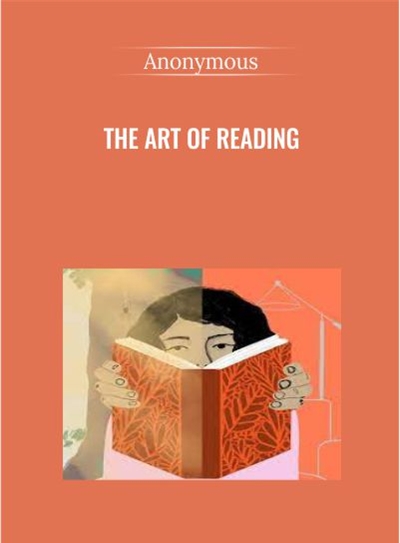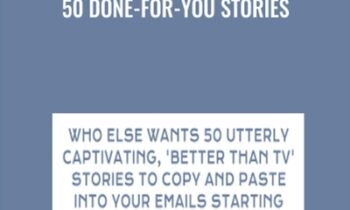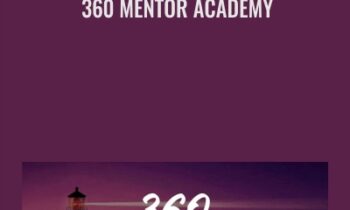The Art of Reading – Shane Parrish
The Art of Reading – Shane Parrish Download. Discover little-known techniques you can use to leap forward in your career, hardwire new skills and ideas int…
Original price was: $249.00.$37.00Current price is: $37.00.
Unlock your potential with the The Art of Reading – Shane Parrish course for only Original price was: $249.00.$37.00Current price is: $37.00. at WSOLib.com! Discover our vast library of over 60,000 downloadable digital courses across Everything Else. Get expert-guided, self-paced learning and save over 80% compared to retail prices. Transform your skills today!
Salepage link: At HERE. Archive:
Ebook “The Art of Reading” is available, If no download link, Please wait 24 hours. We will process and send the link directly to your email
Think you know how to read? (I thought I did, too.)
Discover little-known techniques you can use to leap forward in your career, hardwire new skills and ideas into your brain, and never forget what you read
You know how to read a book. You probably learned how in elementary school.
But do you read optimally? Do you get the most out of every hour you invest in a book? Can you recall what you’ve read days, months, and even years later?
If you’re like most people, the answer is “not even close.”
In fact, I thought I understood what “reading a book” meant until just a few short years ago.
It turns out, I didn’t have a clue.
Hi, I’m Shane Parrish
You might know me as the author of Farnam Street, where we show over 500,000 monthly readers how to make better decisions and excel in the most important areas of their lives.
Over the years, I’ve been featured in publications like Forbes, Business Insider, and The Wall Street Journal. I’ve worked with hedge funds, NFL teams, and universities all over the globe to help them be more effective.
One of the fastest and most effective ways to get smarter and gain new knowledge is to read.
I hope I don’t have to convince you of that.
In fact, most CEOs read an average of 50 books a year.
And many of the most inspiring figures in history — Abraham Lincoln, Marie Curie, Teddy Roosevelt, Winston Churchill, and far too many more to name — attribute their success in life to the knowledge and wisdom they drew from books.
And there’s a simple reason for that:
Books contain the life experience and wisdom of the world’s most accomplished thinkers and doers.
By absorbing their thoughts and experiences, you are able to do more with your time, make better decisions (and fewer mistakes), and live a happier, more productive life.
Reading improves your creativity. It helps you become a more compassionate and empathetic leader. It helps you see the world in new ways.
And studies have shown that active readers are likely to have annual incomes more than five times greater than those who spend little or no time reading.
So we agree. Reading is important.
But reading isn’t enough.
I learned this the hard way.
I wanted to move forward in my career. I wanted to become a better person. I wanted to leave an impact. And many of the people I admired were voracious readers.
So I did what I thought I should do: I read.
And I read a lot. At one point I was averaging over 60 books a year.
But there was a problem. I was investing nearly every waking hour reading — and I wasn’t remembering any of it.
Sure, I could give basic plot points or a few key ideas from each book, but that’s not real knowledge. I couldn’t apply what I had read in any meaningful way.
What’s the point of learning something new if it isn’t there when you need it?
I was wasting my time.
So how were others doing it?
People I looked up to seemed to absorb every word they read.
They could skim reports and get the most salient points in only a fraction of the time. They extracted the most important ideas from books and could put them into action at work and at home. And during conversations, they could easily recall facts, figures, and key concepts from books they read months, and even years, ago.
In today’s world, these people hold the advantage.
I wanted to know how they did it. I knew there were pieces of the puzzle I wasn’t quite getting. So I became obsessed with figuring out those secrets.
I began to study the reading habits of best-selling authors, CEOs, world-class coaches, and other top performers. To my surprise, I realized that most of them followed a variation of the same reading system — and they weren’t even aware of it.
What I learned turned what I thought about reading completely upside down.
I had a lot of assumptions about reading more effectively — and most of them were dead wrong.
I’ll start with three big myths.
Myth #1 You need more time.
I used to think that I wasn’t effective at reading because I wasn’t spending enough time at it.
So I dedicated a year of my life to reading as many books as I possibly could. I read over 150 books in 2014. That equates to thousands of hours of reading.
And you know what?
It didn’t move the needle. Not one bit.
Have you ever tried to tell someone about an incredible book you just read, but you’ve already forgotten the meatiest details and main points of it?
That was me. In fact, other than a brief synopsis of what a book was about, I couldn’t share a single insight that I pulled from all that reading.
It seems counterintuitive, but spending more time reading actually has very little to do with gaining insight.
Myth #2 Success is about finishing.
Isn’t it weird that we pick up a book and feel the need to read it cover-to-cover?
Because we’re taught to read this way when we’re young, this is how we continue to read as adults.
Have you ever stopped reading a book that you didn’t like? Did you feel guilty about picking
up and starting a new one? Many of my students told me they would often force themselves to complete a book they had started, just so they could say they finished it.
In hindsight, that makes no sense. You don’t owe anything to the author, and you don’t get a blue ribbon for finishing a book that doesn’t add value to your life.
The smartest people I know stop reading books when they no longer serve a purpose.
You should, too.
Myth #3 Speed reading works.
Reading faster is not the same as reading better.
A good book, like a good meal or a good conversation, is something that you want to savor.
While I used to fall victim to gimmicks and quick fixes, I now know that anyone looking at speed-reading as a solution has already lost. Whenever you tell yourself “I need to read faster,” you’re missing the point.
The point of reading is not to read faster. It’s to read better.
As I explored the reading habits of the smartest people I knew, I discovered something they all had in common. They all used a version of the same system — the very system that I’m thrilled to share with you today.
Before I share more about what this system is all about, let me be clear about something.
This isn’t speed-reading.
And this isn’t some bag of memory tricks.
This is a scientific, tried-and-true method for extracting the concepts of books, magazines, and blog articles and downloading them into your brain through integrated learning.
That means it becomes a part of your life experience and is there to stay.
Like when a child touches a hot stove. That’s a lesson they’ll never forget. It’s burned into their memory forever. (Pardon the pun.)
And once I show you how to read — and I mean how to really read — you’ll discover how to “experience” learning that you won’t forget.
Introducing The Art of Reading, your guide to reading for insight and understanding.
It took me years to figure out what some of the world’s smartest people were doing when they read a book. I discovered how they sifted valuable information from fluff and, more important, how they seemed to “download” that information into their memory so it would be available to access later.
This is the very same system we use at Farnam Street to read, digest, and extract knowledge from hundreds of books and thousands of articles every year.
This system has been tested on over 1,000 students across dozens of industries with entrepreneurs, CEOs, managers, students, analysts, scientists, and engineers.
It plain works.
Here’s a sample of what you’ll learn:
- How to develop effective reading habits so you can go to bed smarter every day.
- How to focus on what matters — All books and ideas are not created equal. We’ll share the tools that help us determine where to focus and why.
- How to optimize your reading and make the most of your time — When you get clear on why you’re reading something and what you want to get out of it, everything changes.
- How to effectively skim a book — Why waste time reading books that don’t deserve to be read in their entirety? We’ll show you how to save 80% of your time and walk away with the very best a book has to offer.
- Why it’s a good idea to disagree with the author — and how this helps you increase retention.
- The three-step process to integrate knowledge from reading into your life so that you never again forget what you read.
The only comprehensive, user-tested program to dramatically improve your reading and retention.
Here’s what’s included in the Art of Reading system:
INTRODUCTION
Farnam Street Ethos
- Struggling to hit your reading goals? Learn simple strategies that instantly increase your focus and productivity
- Apply Farnam Street’s six core principles to improve your ability to draw insight from what you read and retain it like a sponge
- Debunk common reading myths that hold you back and impair your learning
- Understand the different levels of reading and explore how to use them for wisdom and insight
- Get the inside track on the reading habits and routines of the Farnam Street team
MODULE ONE
Identifying Winners
- Discover the power of unread books (yes, I said unread books)
- Use Farnam Street’s funneling process to make your books compete for attention before you even think about reading them
- Banish book overwhelm by implementing the four filters that Farnam Street uses when deciding to read a book
- The one question you’ll never forget to ask yourself about the books you read
MODULE TWO
Before We Begin
- Most books don’t demand to be read in their entirety — we’ll show you how to decide which ones do
- Why you should start by creating a map of the book — and how to do it in about 15 minutes
- How to evaluate a book in 5–10 minutes online or in a bookstore
- Engage in a fascinating conversation about reading habits and why it’s OK to read several books at once
- What the “Marshmallow Test” can teach us about reading effectively
- How to spot the single biggest opportunity for most readers; it’s simple, yet powerful
MODULE THREE
Critical Thinking
- Find out why note-taking matters and learn the surprising “non-system” system that works for us
- Understand the three key steps of analytical reading, including the one almost everyone skips
- Evaluate how well you stand up to Farnam Street’s definition of the job of a reader (it’s probably not what you think)
- Learn to identify when you need to read with extra caution — hint: it’s not when the reading is challenging
- Channel your learning effectively once you’ve finished a book
- Quickly probe at your depth of understanding with our favorite deep reading question: Do I agree with the author?
MODULE FOUR
Exponential Leaps
- Our favorite module! This is where exponential wins start stacking up
- Generate deep understanding through our process of refereeing the conversation
- Hone your ability to spot when a good narrative is covering up faulty logic or misleading facts
- Become skilled at the tricky task of comparing and contrasting ideas across contexts and perspectives
- Use combinatory play while reading to aid your quest for insight
- Learn to spot and gain deep understanding of building blocks and cornerstone ideas
- Effectively parse out your own ideas, opinions, and insights from your reading
- Develop novel insights naturally, as the result of the process
All New Extras
When you join The Art of Reading, you’ll also get access to special extras that you won’t find anywhere else.
Those extras include:
- Shane’s exclusive and detailed interview with best-selling author Ryan Holiday on how he uses his notecard system. Learn how to extract knowledge from what you’re reading and put it into a usable system. Discover how Ryan uses his system to write one book a year.
- Distillations of reading lessons from a conversation between two master readers. Learn the first thing a great reader does, why you should struggle, and what it means to understand something.
- A roundup of the latest academic research on reading. Learn which note-taking system works best, the pros and cons of reading on electronic devices, and the impact of the Google generation.
- An exclusive conversation between members of the Farnam Street team, with insightful commentary collected from answering questions from previous Art of Reading students.
Secure your future with the The Art of Reading – Shane Parrish course at WSOLib.com! Gain lifetime access to expertly curated content, empowering your career and personal development.
- Lifetime Access: Enjoy unlimited access to your digital courses.
- Huge Savings: Prices are consistently up to 80% lower than original sales pages.
- Secure Transactions: Shop with confidence using our trusted payment methods.
- Actionable Knowledge: Acquire real-world skills from diverse topics.
- Instant Delivery: Start learning immediately after purchase.
- Device Flexibility: Access your courses on desktop, mobile, or tablet.
Begin your learning journey with WSOLib.com!
Specification: The Art of Reading – Shane Parrish
|
User Reviews
Only logged in customers who have purchased this product may leave a review.





There are no reviews yet.